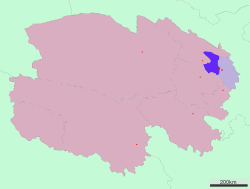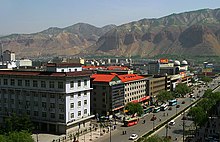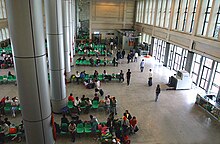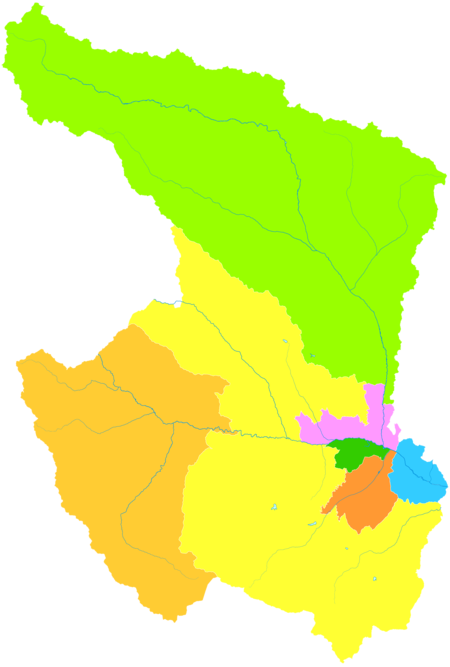Xining
Xining
Tây ninh thị Sining | |
|---|---|
| City of Xining | |
 | |
 Location of Xining City jurisdiction (dark blue) in Qinghai | |
| Coordinates (Qinghai People's Government):36°37′21″N101°46′49″E/ 36.6224°N 101.7804°E | |
| Country | China |
| Province | Qinghai |
| Municipal seat | Chengzhong |
| Government | |
| • Type | Prefecture-level city |
| • Body | Xining Municipal People's Congress |
| •CCP Secretary | Wang Weidong |
| •CongressChairman | Song Chenxi |
| •Mayor | Shi Jianping |
| •CPPCCChairman | Duan Fada |
| Area | |
| •Prefecture-level city | 7,596 km2(2,933 sq mi) |
| • Urban | 2,892.7 km2(1,116.9 sq mi) |
| • Metro | 2,892.7 km2(1,116.9 sq mi) |
| Elevation | 2,275 m (7,464 ft) |
| Population (2020 census)[1] | |
| •Prefecture-level city | 2,467,965 |
| • Density | 320/km2(840/sq mi) |
| •Urban | 1,954,795 |
| • Urban density | 680/km2(1,800/sq mi) |
| •Metro | 1,954,795 |
| • Metro density | 680/km2(1,800/sq mi) |
| GDP[2] | |
| •Prefecture-level city | CN¥164.4 billion US$18.2 billion |
| • Per capita | CN¥ 49,185 US$ 7,897 |
| Time zone | UTC+8(China Standard) |
| Postal code | 810000 |
| Area code | 971 |
| ISO 3166 code | CN-QH-01 |
| License plate prefixes | Thanh A |
| Website | www.xining.gov.cn(in Chinese) |
| Xining | |||||||||||
|---|---|---|---|---|---|---|---|---|---|---|---|
 "Xīníng" inTraditional(top) andSimplified(bottom) Chinese characters | |||||||||||
| Chinese name | |||||||||||
| Simplified Chinese | Tây ninh | ||||||||||
| Traditional Chinese | Tây ninh | ||||||||||
| Postal | Sining or Ziling | ||||||||||
| Literal meaning | "Western tranquility" | ||||||||||
| |||||||||||
| Tibetan name | |||||||||||
| Tibetan | ཟི་ལིང | ||||||||||
| |||||||||||
| Mongolian name | |||||||||||
| Mongolian Cyrillic | Сэлэнг | ||||||||||
| Mongolian script | ᠰᠢᠨᠢᠩ | ||||||||||
| |||||||||||
Xining[a]is thecapitaland most populous city ofQinghaiprovince inwestern China[4]and the largest city on theTibetan Plateau.As of the 2020 census, it had 2,467,965 inhabitants (2,208,708 as of 2010), of whom 1,954,795 lived in the built-up (or metro) area made of 5 urban districts.[5]The city lies in theHuangshui River Valley,also known as Tsongkha (Tibetan:ཙོང་ཁ་), and owing to its high altitude, has a cool climate on the borderline betweencool semi-aridand dry winterhumid continental.
Xining was a commercial hub along theNorthern Silk Road'sHexi Corridorfor over 2000 years, and was a stronghold of theHan,Sui,Tang,andSongdynasties' resistance against nomadic attacks from the west. Although long a part ofGansuprovince, Xining was added to Qinghai in 1928. Xining holds sites of religious significance to Muslims and Buddhists, including theDongguan MosqueandKumbum Monastery.It is connected by theQinghai–Tibet railwaytoLhasa, Tibetand connected bya high-speed railwaytoLanzhou, GansuandÜrümqi, Xinjiang.
The city is home toQinghai University,acomprehensive universityand the onlyDouble First-Class Universityin Xining.
History
[edit]Xining has a history of over 2,100 years[6]and was a chief commercial hub on theHexi Corridorcaravan route toTibet,handling especially timber, wool and salt in ancient times. The trade along the Hexi Corridor was part of a larger trade corridor along theNorthern Silk Road,whose use was intensified in the 1st century BC after efforts by theHan dynastyto control this route.[7]
Under the Han dynasty (206 BC – 220 AD), a county called Linqiang was established to control the localQiang tribesmen.It was again a frontier county under theSui(581–618) andTang(618–907) dynasties; during the 7th and early 8th centuries it was a center of constant warfare withTuyuhunandTibet.In 763, it was overrun by the Tibetans and while under Tibetan control was known to the Chinese asQingtang cheng(Thanh đường thành). Recovered by theSong dynastyin 1104, it received the name Xining (meaning "peace in the west" ) and has been the seat of a prefecture or superior prefecture under that name since that time. The founder ofGelugTsongkhapa(Tibetan:ཙོང་ཁ་པ་, meaning: "the man fromTsongkha".c. 1357–1419) was born in the 14th century, and on the site of his birthplace theKumbum Monasterywas founded in the late 16th century, establishing Xining as an important religious center for theGelugSchool of Buddhists.
A majorearthquake occurred May 22, 1927,measuring at amagnitudeof 7.6. It was one of the deadliest earthquakes in China with a total count of over 40,000 deaths. It also caused large land fractures.
Xining was the extraterritorial capital of theKoko Norterritory and remained inGansuuntil 1928, when it became the provincial capital of the newly established independent province of Qinghai.[8][9]
Xining was subjected to aerial bombardment byJapanesewarplanes in 1941 during theSecond Sino-Japanese War.The bombing spurred all ethnicities in Qinghai, including the local Qinghai Mongols and Qinghai Tibetans, against the Japanese.[10][11]The Salar Muslim GeneralHan Youwendirected the defense of the city of Xining during air raids by Japanese planes.[12][13]
Xining was given municipal status in 1945.
Under the rule of GovernorMa Bufang,Xining, like the rest of Qinghai, underwentindustrializationand modernization. In 1947 the USA sold Ma Bufang a piped water (sewage) system which was installed in Xining.[14]Ma Bufang also promoted education. He made businessmen methodically clean up Xining by serving as insect exterminators.[15]

Since the late 1950s, when theLiujiaxia Damandhydroelectricproject came into operation in neighboringGansu province,Xining has been linked by a high-tension electrical grid to both Liujia and Lanzhou. It also uses localcoalfrom mines atDatong Countyto the north. A modern woollen mill was installed at Xining before 1957. The city also has a leather industry and is a market for salt from theQaidamregion. During the late 1950s medium-sized iron and steelworks were built there, supplying metal to Lanzhou.
Construction of a highway to the mineral-richQaidambasin, and completion in 1959 a link to the Chinese rail network viaLanzhouin Gansu province, has spurred industrial development. This effort was part of a plan of the central government to rapidly exploit oil and pasturage in the Xining area beginning in the 1950s.[16]
Geography and climate
[edit]Xining is located in the eastern part ofQinghaiProvince and lies on theHuangshui River.The four urban districts have a total area of 343 km2(132 sq mi).
Xining is located on the eastern edge of theQinghai–Tibet Plateauand the upper reaches of theHuangshui River.It is the political, economic, and cultural center ofQinghai Provincewith an average altitude of about 2,200 metres (7,200 ft). Human activity in the region can be traced to 2,100 years ago. During theWestern and Eastern Han dynasties,owing to its developingagriculture,Xining was paid notice due to its economic and military significance. As well as being an important hinge between the Central Plains and the western part of China in ancient times, Xining was an important link in theSilk Road.It continues to be an important rail and road link to the hinterlands of the Qinghai–Tibet Plateau.
Xining has also been dubbed the Summer Resort Capital of China owing to its cool summer, with a borderlinecold semi-arid climate(KöppenBSk)/dry winterhumid continental climate(Dwb). Conditions are influenced by the aridity and high altitude. Nights are cold or cool throughout the year, and thediurnal temperature variationoften reaches or exceeds 15 °C (27 °F). The monthly 24-hour average temperatures ranges from −7.9 °C (17.8 °F) in January to 17.5 °C (63.5 °F) in July; the annual mean is 6.0 °C (42.8 °F), still making it one of the warmest locations in Qinghai due to the low elevation by provincial standards. Rainfall falls mainly from May to September, and the area is often dry and sunny: with monthly percent possible sunshine ranging from 49 percent in September to 67 percent in November, the city receives 2,540 hours of bright sunshine per year. Extreme temperatures have ranged from −26.6 °C (−16 °F) to 36.5 °C (98 °F).[17]Snow cover is very sparse due to the dry winters.
| Climate data for Xining, elevation 2,295 m (7,530 ft), (1991–2020 normals, extremes 1951–2010) | |||||||||||||
|---|---|---|---|---|---|---|---|---|---|---|---|---|---|
| Month | Jan | Feb | Mar | Apr | May | Jun | Jul | Aug | Sep | Oct | Nov | Dec | Year |
| Record high °C (°F) | 13.9 (57.0) |
20.8 (69.4) |
26.2 (79.2) |
31.8 (89.2) |
30.7 (87.3) |
31.9 (89.4) |
36.5 (97.7) |
34.0 (93.2) |
29.9 (85.8) |
25.2 (77.4) |
19.3 (66.7) |
13.3 (55.9) |
36.5 (97.7) |
| Mean daily maximum °C (°F) | 2.1 (35.8) |
5.8 (42.4) |
11.0 (51.8) |
16.6 (61.9) |
20.2 (68.4) |
23.2 (73.8) |
25.1 (77.2) |
24.2 (75.6) |
19.6 (67.3) |
14.5 (58.1) |
8.6 (47.5) |
3.4 (38.1) |
14.5 (58.2) |
| Daily mean °C (°F) | −7.9 (17.8) |
−3.6 (25.5) |
2.2 (36.0) |
8.3 (46.9) |
12.3 (54.1) |
15.6 (60.1) |
17.5 (63.5) |
16.6 (61.9) |
12.2 (54.0) |
6.2 (43.2) |
−0.7 (30.7) |
−6.3 (20.7) |
6.0 (42.9) |
| Mean daily minimum °C (°F) | −14.6 (5.7) |
−10.4 (13.3) |
−4.4 (24.1) |
1.4 (34.5) |
5.7 (42.3) |
9.2 (48.6) |
11.6 (52.9) |
11.1 (52.0) |
7.4 (45.3) |
0.9 (33.6) |
−6.5 (20.3) |
−12.6 (9.3) |
−0.1 (31.8) |
| Record low °C (°F) | −24.9 (−12.8) |
−20.7 (−5.3) |
−16.9 (1.6) |
−12.5 (9.5) |
−2.3 (27.9) |
0.2 (32.4) |
4.2 (39.6) |
3.7 (38.7) |
−1.1 (30.0) |
−12.5 (9.5) |
−19.0 (−2.2) |
−26.6 (−15.9) |
−26.6 (−15.9) |
| Averageprecipitationmm (inches) | 1.8 (0.07) |
1.9 (0.07) |
8.8 (0.35) |
20.7 (0.81) |
53.8 (2.12) |
64.5 (2.54) |
81.5 (3.21) |
87.0 (3.43) |
68.0 (2.68) |
23.3 (0.92) |
5.2 (0.20) |
1.2 (0.05) |
417.7 (16.45) |
| Average precipitation days(≥ 0.1 mm) | 3.2 | 2.9 | 4.9 | 7.1 | 11.7 | 14.4 | 15.4 | 14.5 | 14.4 | 7.7 | 3.2 | 2.1 | 101.5 |
| Average snowy days | 5.1 | 5.8 | 7.0 | 3.4 | 0.4 | 0 | 0 | 0 | 0.1 | 1.5 | 4.2 | 4.0 | 31.5 |
| Averagerelative humidity(%) | 48 | 45 | 46 | 47 | 55 | 61 | 66 | 69 | 72 | 67 | 58 | 52 | 57 |
| Mean monthlysunshine hours | 196.7 | 200.3 | 223.9 | 232.8 | 240.5 | 230.1 | 223.8 | 215.8 | 181.4 | 200.0 | 201.8 | 192.6 | 2,539.7 |
| Percentpossible sunshine | 63 | 65 | 60 | 59 | 55 | 53 | 51 | 52 | 49 | 58 | 67 | 64 | 58 |
| Source: China Meteorological Administration[18][19][20] | |||||||||||||
River management
[edit]In 2007, theWorld Banklent US$1 billion to aidriver treatmentin Xining, includingSanxian County's anti-floodingproject, with an added US$1 billion to support infrastructure. Qinghai has invested large amounts in the treatment of Huangshui Main River and Nanchuan River, totalling 24.5 km (15.2 mi). However, a treatment on a 40 km (25 mi) river course and 10 flash flood relief channels remain pending due to lack of equipment. In Sanxian County, a 108.4 m (356 ft) long river course and 80 flash flood relief channels need treatment.
Air quality
[edit]According to a 2011 World Health Organization (based on Chinese statistics), Xining has the second worstair quality(annual mean PM10 ug/m3 of 141) among eleven western China cities, and is worse than Beijing (121).[21]
Economy
[edit]

TheGDPper capita was 49,200 RMB (US$7,897) in 2015. Its main industries are wool spinning and textiles, fur, meat, milk, salt, and light processing industries.
Economic and Technological Development Zones
[edit]- Xining Economic & Technological Development Zone
Xining Economic & Technological Development Zone XETDZ) was approved as state-level development zone in July 2000. It has a planned area of 4.4 km2(1.7 sq mi). XETDZ lies in the east of Xining, 5 km (3.1 mi) away from downtown. The XETDZ is the first of its kind at the national level on the Qinghai-Tibet Plateau. It is established to fulfill the nation's strategy of developing the west.
XETDZ enjoys a convenient transportation system, connected by the Xining–Lanzhou expressway and run through by two main roads, the broadest roads of the city. It is 4 km (2.5 mi) away from the railway station,[which?]15 km (9.3 mi) from Xining Airport.
It focuses on the development of following industries: chemicals based on salt lake resources, nonferrous metals, and petroleum and natural gas processing; special medicine, foods and bio-chemicals using local plateau animals and plants; new products involving ecological and environmental protection, high technology, new materials as well as information technology; and services such as logistics, banking, real estate, tourism, hotel, catering, agency and international trade.[22]
Demographics
[edit]According to the2020 Chinese census,the prefecture-level city of Xining has a population of 2,467,965 inhabitants (compared to 2,208,708 as of the2010 Chinese census),[23][24]of whom 1,954,795 lived in the built-up (or metro) area made of 5 urban districts.[25]
At present, four districts, three counties and a national economic and technological development zone are under the administration of the local government. With a population of more than two million, Xining is the first city on the upper reaches of theYellow Riverto achieve a population in the millions.
Ethnic diversity
[edit]There are about 37 nationalities living here, though only theHan,Hui,Monguor/Tu andTibetansare numerically significant. Local traditions and customs are influenced by the Tibetans, Monguor, Muslims and Han. In the 2010 Census numbers, Han Chinese represent 74.04 percent of the total population of Xining, while Hui (16.26 percent), Tibetan (5.51 percent) and Tu (2.6 percent) are the mainminority groups in the city.
Religion
[edit]

Located in the southwest part of Xining City, theKumbum MonasteryorTa'er Monasteryis one of six famous monasteries in theGelug(also calledYellow Hat Sect) of Tibetan Buddhism and has hundreds of monks.
Having a history of over 600 years, theDongguan Mosque,located in the Xining City Zone, is one of the most famousmosquesin the northwest region of China. It has splendid and diversiform towers, walls and halls in the mosque.
Another unique religious structure is theBeishan Si(North Mountain Temple), aTaoistfacility.
There are more than 300 Christian meeting points in Xining.[26]
The Catholic minority is pastorally served by the (pre-diocesan)Apostolic Prefecture of Xining.
Administrative divisions
[edit]The municipality oversees sevendistrictsandcounties.The data here are presented in km² and in population according to 2010 Census:
| Map | |||||||
|---|---|---|---|---|---|---|---|
| Name | Simplified Chinese | Hanyu Pinyin | Area (km2) | Population (2010) |
Density (/km2) | ||
| Urban | |||||||
| Chengzhong District | Thành trung khu | Chéngzhōng Qū | 11 | 296,987 | 26,999 | ||
| Chengdong District | Thành đông khu | Chéngdōng Qū | 115 | 359,688 | 3,128 | ||
| Chengxi District | Thành tây khu | Chéngxī Qū | 79 | 242,627 | 3,071 | ||
| Chengbei District | Thành bắc khu | Chéngběi Qū | 138 | 299,002 | 2,167 | ||
| Suburban | |||||||
| Huangzhong District | Hoàng trung khu | Huángzhōng Qū | 2,430 | 437,835 | 180 | ||
| Rural | |||||||
| Huangyuan County | Hoàng nguyên huyện | Huángyuán Xiàn | 1,609 | 136,632 | 85 | ||
| Datong Hui and Tu Autonomous County |
Đại thông hồi tộc thổ tộc tự trị huyện | Dàtōng Huízú Tǔzú Zìzhìxiàn | 3,090 | 435,937 | 139 | ||
Education
[edit]Colleges and universities
[edit]Private schools
[edit]Xining International Academyis an English-language international school.
Transportation
[edit]
Xining is situated in a fertile mountain basin in the valley of the Huangshui (river), a tributary of the Yellow River, that acts as a river port. The city lies about 200 km (120 mi) west ofLanzhou,the capital ofGansuprovince, on what was traditionally the main trade route fromnorthern ChinaintoTibetand theQaidam Basin.These routes are now followed by modernhighways.
Railway
[edit]
Since 1959Xining stationhas been connected by theLanzhou–Qinghai RailwaytoChina's railway network.Later, this railway was extended into the Qaidam area viaHaiyannearQinghai LaketoGolmud,and, since 2006, toLhasa,Tibet.(See theQinghai–Tibet Railway).
The second major railway serving Xining is theLanzhou–Xinjiang High-Speed Railway,opened in December 2014. When first opened, it just provided high-speed train service to Lanzhou andUrumqi(and points in between). With the opening of theBaoji–Lanzhou high-speed railwayon July 9, 2017, it has been connected to the rest of the nation's high-speed rail network.
Unlike many other Chinese cities, where the conventional and high-speed trains stop at different train stations,Xining railway stationis served by both types of trains. Thus it can be used as a transfer point for e.g. a passenger traveling fromXinjiangtoTibet.
Air
[edit]Xining Caojiapu International Airportserves the area with regularly scheduled passenger flights to major Chinese cities including Beijing, Shanghai, Hong Kong, Chengdu, Kunming, Xi'an, and Wuhan.
Highway
[edit]- China National Highway 214
- China National Highway 227
- China National Highway 315
- G6 Beijing–Lhasa Expressway
Food
[edit]Xining's cuisine is distinct from other Chinese cities and mainly uses food products native to the area.
Local specialties include: Feng'er Liji (a round lamb tenderloin), Danbai Chongcao Ji (a medicine cuisine made of chicken, Chinesecaterpillar fungusand eggs), and Jinyu Facai (pork wrapped in flagelliformnostocand shaped as a goldfish).
There are also many small restaurants offering noodles. Gan Ban is a very common noodle dish. Perhaps Mian Pian, which means "noodle leaves" is the most common noodle plate among the Qinghai people. On the streets, many Muslims sell spicylamb brochettes.Due to the cold climate, residents of Xining are also fond of strong spirits; Xining has the reputation of being one of the regions of heaviest alcohol consumption in China.[citation needed]
Notes
[edit]References
[edit]- ^"China: Qīnghăi (Prefectures, Cities, Districts and Counties) - Population Statistics, Charts and Map".
- ^Thanh hải tỉnh thống kế cục, quốc gia thống kế cục thanh hải điều tra tổng đội (August 2016).《 thanh hải thống kế niên giám -2016》.Trung quốc thống kế xuất bản xã.ISBN978-7-5037-7834-6.Archived fromthe originalon 28 December 2017.Retrieved5 June2017.
- ^"Xining".LexicoUK English Dictionary.Oxford University Press.Archived fromthe originalon 17 April 2021.
- ^"Illuminating China's Provinces, Municipalities and Autonomous Regions".PRC Central Government Official Website.Retrieved17 May2014.
- ^"China: Qīnghăi (Prefectures, Cities, Districts and Counties) - Population Statistics, Charts and Map".
- ^[1]ArchivedSeptember 29, 2007, at theWayback Machine
- ^"Silk Road, North China [Northern Silk Road, North Silk Road] Ancient Trackway: The Megalithic Portal and Megalith Map".Megalithic.co.uk.Retrieved7 February2014.
- ^Frederick Roelker Wulsin, Joseph Fletcher, Peabody Museum of Archaeology and Ethnology, National Geographic Society (U.S.), Peabody Museum of Salem (1979). Mary Ellen Alonso (ed.).China's inner Asian frontier: photographs of the Wulsin expedition to northwest China in 1923: from the archives of the Peabody Museum, Harvard University, and the National Geographic Society(illustrated ed.). The Museum: distributed by Harvard University Press. p. 49.ISBN0-674-11968-1.Retrieved28 June2010.
{{cite book}}:CS1 maint: multiple names: authors list (link)(Original from the University of Michigan) - ^Graham Hutchings (2003).Modern China: a guide to a century of change(illustrated, reprint ed.). Harvard University Press. p. 351.ISBN0-674-01240-2.Retrieved28 June2010.
- ^Hồi cố 1941 niên nhật cơ oanh tạc tây ninh: Cải biến thanh hải lịch sử quỹ tích - kháng chiến cố sự - kháng nhật chiến tranh kỷ niệm võng.
- ^"1941: Nhật quân phi cơ oanh tạc tây ninh -- đảng sử tần đạo - nhân dân võng".
- ^"Hoài niệm ngã đích phụ thân ── hàn hữu văn".Archived fromthe originalon 22 March 2012.Retrieved3 April2011.
- ^http://www.kunlunpai.cn/thread-1211-1-1.html[permanent dead link]
- ^"CITY IN WEST CHINA TO GET PIPED WATER; American 'Sells' Warlord at Sining on System to Aid Health --People Suspect Clear Fluid".THE NEW YORK TIMES.3 February 1947.Retrieved28 November2010.
- ^HENRY R. LIEBERMAN (15 September 1948)."ENLIGHTENED RULE BOLSTERS TSINGHAI; General Ma, War Lord, Enjoys Passion for Education -- He Taxes as Need Arises".The New York Times.Retrieved28 November2010.
- ^Greg Rohlf (1 October 2003). "Dreams of Oil and Fertile Fields".Modern China.29(4). Mcx.sagepub.com: 455–489.doi:10.1177/0097700403257134.S2CID143975998.
- ^Trung quốc khí tượng khoa học sổ cư cộng hưởng phục vụ võng.China Meteorological Administration. Archived fromthe originalon 2 March 2015.Retrieved22 February2014.
- ^Trung quốc khí tượng sổ cư võng - WeatherBk Data(in Chinese (China)).China Meteorological Administration.Retrieved15 April2020.
- ^ Trung quốc địa diện quốc tế giao hoán trạm khí hầu tiêu chuẩn trị nguyệt trị sổ cư tập ( 1971-2000 niên ).China Meteorological Administration.Archived fromthe originalon 21 September 2013.Retrieved25 May2010.
- ^CMA đài trạm khí hầu tiêu chuẩn trị (1991-2020)(in Chinese).China Meteorological Administration.Retrieved11 April2023.
- ^WHO report OAP_database_8_2011.xls
- ^"Xining Economic & Technology Development Zone | China Industrial Space".Rightsite.asia. 18 November 2013.Retrieved7 February2014.
- ^Tây ninh thị 2010 niên đệ lục thứ nhân khẩu phổ tra chủ yếu sổ cư công báo [1](in Simplified Chinese). Xining Municipal Bureau of Statistics. 14 May 2011.Retrieved17 July2015.
- ^"Data from the Sixth National Population Census of the People's Republic of China"(in Chinese). Compilation by LianXin website. Archived fromthe originalon 25 March 2012.Retrieved7 February2014.
- ^"China: Qīnghăi (Prefectures, Cities, Districts and Counties) - Population Statistics, Charts and Map".
- ^"Discovering China: CityScape".Library.thinkquest.org. Archived fromthe originalon 8 May 2013.Retrieved7 February2014.








